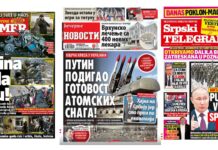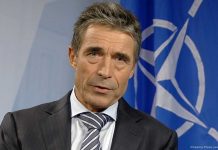BRUSSELS — Sixty-one years after it was created to defend Europe, NATO is busier than ever. Its forces are deployed in the largest operation in its history, 130,000 strong, to fight a violent insurgency, train local police and army forces and keep the peace in Afghanistan, some 5,000 kilometers from NATO headquarters in Brussels.
Thousands of NATO troops also continue to foster stability and security in the Balkans. And for the past two years, NATO ships have plowed the seas near Somalia to counter the growing scourge of piracy.
Later this year, the 28 leaders of the alliance will gather to codify NATO’s renaissance in relevance. They will agree on a new strategic concept setting forth how NATO will tackle the challenges of the 21st century with as much success as it tackled the challenges of the previous century. But this agreement will mean much less if, at the same time, NATO leaders fail to invest in what binds the allies together as an integrated military alliance.
And here lies a challenge to NATO that is perhaps even greater than ongoing operations — that the global financial crisis and cuts in defense outlays will fall disproportionately on what makes NATO strong.
The Atlantic alliance is not just an organization that brings together a community of 28 nations united by their commitment to common values and dedicated to their collective defense and cooperative security. It is a military alliance that, unique in history, fields forces that can operate together in any environment, an integrated military command structure to control operations anywhere, and core capabilities that few allies could buy by themselves.
These assets distinguish NATO as a military alliance from a mere coalition of the willing. And they come remarkably cheap. NATO’s commonly funded budget amounts to just 0.3 percent of overall NATO defense spending — 3 pennies for every $10 spent. Yet the temptation in many allied capitals facing austerity is to try and balance their defense budgets on the backs of this common budget.
Not only will this not work — the sums involved are just too tiny to help their budgets — but it is a shortsighted way to provide for our common security. NATO common funding is a bargain — for the largest European countries, a contribution of about 10 cents buys a dollar worth of defense, because the other 90 cents are paid by other allies.
Every crisis is an opportunity, and this global financial crisis is no exception. Rather than cutting NATO’s common budget, this is the time to invest in joint capabilities.
Take strategic airlift — a very expensive capability that is absolutely essential in this globalized world. Few countries can afford to buy large numbers of transport planes, which is why 10 allies and two partner countries decided to pool their resources and acquire three huge C-17 transport aircraft together. Like partial ownership of commercial jets, this consortium allows nations to buy flying hours on a C-17 and use it for whatever purpose they see fit — ferrying troops to Afghanistan or humanitarian assistance to Haiti.
It isn’t just high-ticket items that multinational funding provides the allies; it’s also core capabilities that multiply the effectiveness of national forces.
Take missile defense. Over the past few years, NATO has funded a command and control system, called ALTBMD, that links nationally owned radars and interceptors into a much more capable defense against ballistic missile attacks. Through this NATO-funded system, early warning data from one ally can be sent to another ally fielding an interceptor to protect deployed forces against attack, making these national capabilities all that more effective and at far less cost.
Later this year, NATO leaders will decide whether to expand that capability, at a cost to the 28 allies of less than €200 million over ten years, to knit together sensors and interceptors capable of protecting NATO territory and populations against longer range missile attacks.
The NATO common budget and multi-national funding of key capabilities is the central glue that binds 28 separate nations into a common military fighting machine. Joint training and exercises ensure they can operate together.
The integrated command system enables commanders to control operations on alliance territory and beyond. And critical capabilities — like NATO’s AWACS planes and AGS unmanned vehicles — provide soldiers and pilots with an overview of the situation in the air and on the ground. It is these commonly funded assets that have made NATO the most successful alliance in history.
The message is clear: As all of us scrutinize how we spend scarce defense dollars, pounds and euros, we should find savings where we can — but we should also decide to spend those funds that remain in ways that will have the maximum benefit for our security. We may not be able to spend more, but we can spend smarter by spending more together.
July 22, 2010
By IVO DAALDER
Ivo Daalder is the U.S. ambassador to NATO.







